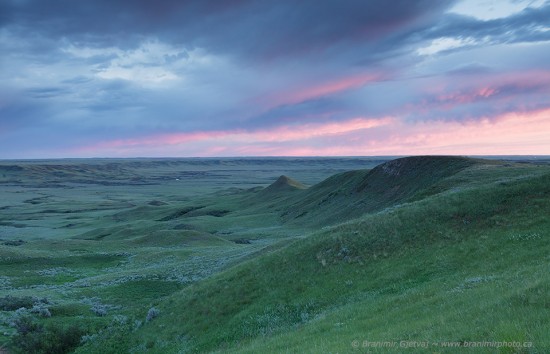For over 75 years, the Canadian government has managed a large swath of community pastures across the Canadian Prairies, comprising of 929,000 hectares (2.3 million acres) of some of the largest unfragmented tracts of grasslands found anywhere in the world. If grasslands included in the Community Pasture Program (CPP) were a country, they would rank 168th in size – slightly larger than the Republic of Cyprus and right behind Lebanon. Or in the Canadian context, the PFRA community pastures cover the area that is 1.6 times the size of Prince Edward Island.
The federal Community Pasture Program was established under the Prairie Farm Rehabilitation Administration (PFRA) in mid 1930s. The pasture program was created to reclaim badly eroded lands caused by a prolonged and disastrous drought which forced thousands of people to leave the Canadian Prairie region between 1931 and 1941. At the time of establishment, the PFRA goals were to stabilize and reduce the effects of soil erosion and address the lack of water resources on agricultural land. Over the years, PFRA mandate expanded to include management of a “productive, bio-diverse rangeland and to promote environmentally responsible land use practices”. The program uses cattle grazing as the primary tool to maintain a healthy and diverse landscape, which is representative of the natural functioning prairie ecosystems. Over many years of careful management, PFRA pastures reclaimed the badly mismanaged rangeland and now provide stable grazing access to 2,500 ranchers who graze over 200,000 heads of cattle each year. In addition to securing quality grazing to livestock producers, PFRA pastures provide habitat for the prairie’s unique and imperiled plant and animal species. Did you know that 31 of threatened and species at risk of extinction in Canada call the PFRA pastures their home?
Out of 85 community pastures in the national system, 60 are located in Saskatchewan, with a total surface area of 729,000 hectares (1.8 million acres). This represents almost 16 % of the natural prairie that still remain in the province. In addition to community pastures currently managed by federal agencies, the province of Saskatchewan owns and manages 56 community pastures for a total surface area of 2.57 million acres. Majority of this land is under native pasture cover. The Saskatchewan Pasture Program operates on similar principles as the CPP, but with less emphasis on management for conservation purposes.
The Government of Canada had made a decision that management of the Community Pasture Program is no longer with the federal’s government mandate. In the Federal Budget tabled in March of 2012, the AAFC announced plans to discontinue pasture operations and gradually divest itself from the control of the land over a 5 year period. Given that a substantial proportion of pasture lands is owned by the provinces of Saskatchewan and Manitoba, management and control of large area of rangeland will revert to the provinces. In summer of 2012, the province of Saskatchewan announced that it plans to sell or lease the PFRA pastures on a pasture-by-pasture basis. This is very different approach compared to what the government of Manitoba plans to do: keep the community pastures in public ownership as a Crown land and lase it to the newly formed pasture patron co-operative. The idea of selling (or leasing) and managing the pastures on individual basis does not bring good news for many prairie animals and plants. Ranchers have been good stewards and managers of the land, and prairie species benefited from proper range management. However, economic hardship (of which have been many instances in this part of the world) might put the importance of financial returns ahead of the concern for pasture ecological health. With the current rapid rise in the land resale values, it is quite possible that an outside investors might purchase some of the pastures and manage them with disregard to the long-term ecological health and wildlife well-being.
The community pastures are a public resource and they belong to the people of Saskatchewan. They are an important part of our natural and cultural heritage and it is very disconcerning that Saskatchewan government is rushing ahead with the decision to sell the community-owned pastures without properly consulting with numerous stakeholders that have interest in the long-term environmental health of PFRA pastures. Until I post more information about this issue of great nature conservation importance, have a look at a recent article from www.protecttheprairie.ca Check out an excellent overview article titled PFRA Community Pastures in Transition – Where is the Beef? written by the University of Saskatchewan adjunct professor Joe Schmutz.


